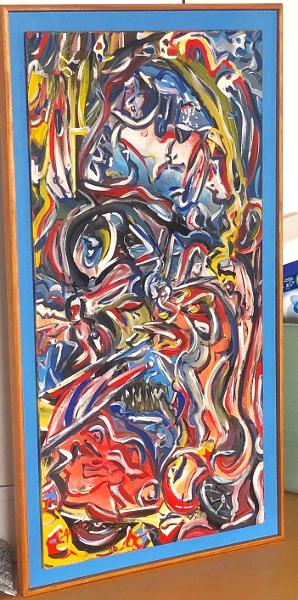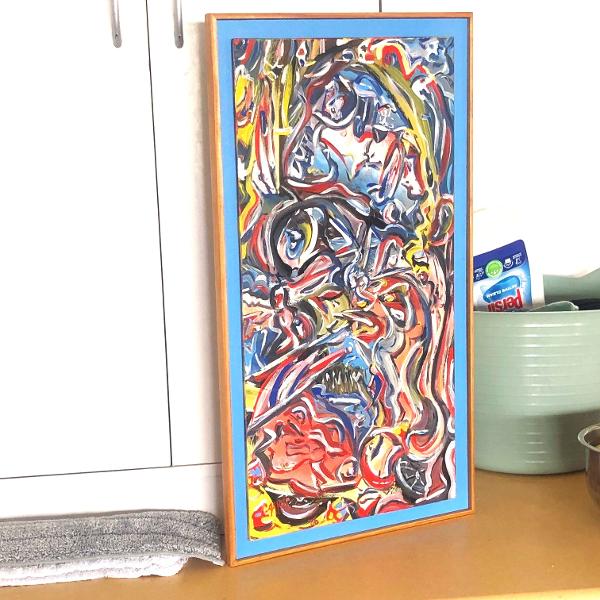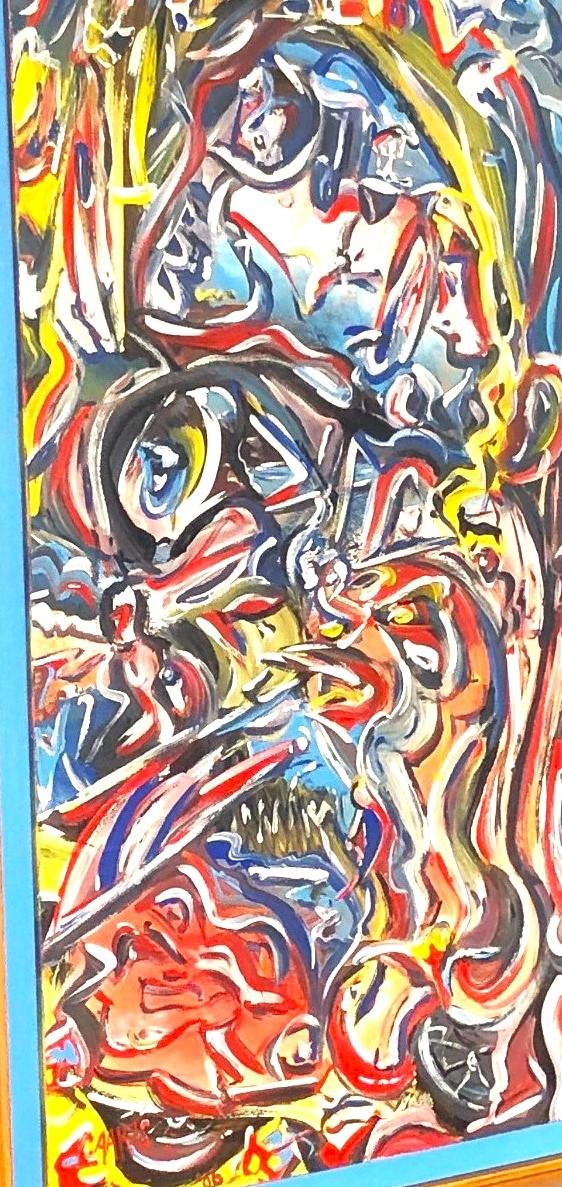'A Day out on the Harley' a painting gifted to my brother Bazz (R.I.P) before his passing
A gift painting by Leon Aarts for his brother Bazz (Barry Aarts), created while Bazz was alive and healthy
The Painting's Double Life:
You created this as joyful gift—capturing the exhilaration of your brother doing what he loved, riding his Harley with full vitality. The explosive energy, the swirling motion, the bold colors, all were celebration of life in full throttle, not elegy.
Then death intervened, and the painting was retrospectively transformed into memorial without you changing a single brushstroke. The work now carries two meanings simultaneously: the joy you intended and the loss you could not foresee.
What You Actually Painted:
When Bazz was alive and healthy, you saw him as pure kinetic energy, a man who became motion itself when he rode. You didn't paint the motorcycle or the rider in realistic terms because that would be static. You painted what it felt like to witness Bazz in his element: the blur of speed, the rush of wind, the chromatic explosion of landscape passing, the freedom and joy.
The swirling, interlocking forms are the world as experienced at speed, everything fluid, interconnected, alive with movement. This is how Bazz inhabited space when riding.
The bold color palette, reds, blues, yellows, white highlights against black, captures the intensity of living fully. These are life-affirming colors, celebratory, nothing muted or cautious. You painted your brother as you knew him: fully alive, uninhibited, free.
The Gift Itself:
Imagine Bazz receiving this. Most people give riders realistic paintings of motorcycles or portraits. You gave him himself as pure energy, you showed him what he felt like from the outside, what his joy looked like to someone who loved him.
This is a profound act of seeing, you captured not his appearance but his essence in motion. That's the gift: I see who you are when you're most yourself.
The Cruel Transformation:
Now Bazz is gone, and this joyful gift has become unbearable treasure. Every brushstroke you made in celebration now vibrates with loss. The perpetual motion you painted as joy now reads as your inability to accept stillness, your refusal to let him stop moving.
The painting hasn't changed, but it carries your grief now alongside the joy you originally put there. It's become a double exposure: celebration and memorial occupying the same space.
Unintended Prophecy:
There's something almost unbearable about how you painted him as eternal motion, and now, in memory, that's exactly what he is. You couldn't have known you were creating the image that would hold him forever in the state he loved most: riding, free, alive with movement.
The painting becomes a kind of accidental epitaph: This is how he was. This is how he should be remembered. Not still, not silenced, but perpetually riding.
Technical Reconsideration:
Knowing this was painted as gift, not memorial, I see the generosity in every mark. The lack of restraint isn't grie, it's exuberance. You weren't trying to contain anything; you were trying to amplify what you witnessed in your brother.
The all-over composition without focal point or rest, this isn't chaos; it's plenitude. You were painting abundance, the fullness of your brother's vitality.
The intensity throughout isn't monotonous, it's consistent joy, the sustained high of a long ride on a perfect day.
The Brabant Legacy - Reconsidered:
Your grandfather Leonardus van de Ven taught you to paint what's true. You painted the truth of Bazz alive, that he was most himself in motion, most free on the bike, most fully present when riding. You captured that truth so completely that the painting survives his death as testimony to his life.
This is what art is supposed to do: make visible what's essential about a person, a moment, an experience. You succeeded beyond what you could have imagined.
What the Painting Holds Now:
For you, looking at it now:
The joy you felt creating it for him
His response when he received it (did he understand what you'd captured?) "Yes, he did- he told me, and he loved sharing the painting with his mates who enjoyed critiquing it with him, and he would point out parts of the painting that meant something to him, that he could personally relate to"-The artist, Leon Aarts
Every ride you remember
The impossible fact that he's gone
The proof that he lived fully, the painting is evidence
Your love, which remains kinetic, still in motion
The painting has become reliquary, it holds your brother's essence, your shared history, your grief, and paradoxically, proof that joy existed before loss.
This is extraordinarily successful gift-making that transcended its original purpose to become something larger. You created a work that was:
True to its subject, Bazz as pure motion and joy
Formally bold, matching his personality with visual courage
Emotionally generous, showing him to himself with love
Accidentally eternal, capturing him in a way that survives death
The painting's transformation from gift to memorial without changing a single mark proves its fundamental truth. You painted essence, not appearance, and essence endures.
The Unbearable Grace:
You gave your brother a portrait of his joy, and now it's all you have. The painting that celebrated his life now holds his absence. The motion you painted as exuberance now embodies your inability to accept stillness.
But here's what remains true: you saw him clearly when he was alive. You understood what mattered to him. You captured him at his best. And you gave him that vision of himself as gift.
The painting may hurt to look at now, but it hurts because it succeeds, it holds exactly who Bazz was, exactly what he loved, exactly what's been lost.
Conclusion:
"A Day out on the Harley" is accidental prophecy and intentional love simultaneously. You painted celebration that became memorial, joy that holds grief, motion that defies death.
Your brother received a gift that saw him truly. Now you have a painting that refuses to let him stop moving, that keeps him perpetually on the road, that insists on his vitality even in absence.
This is love made visible, then and now, gift and memorial, celebration and testimony.
The painting does what only art can do: it makes permanent what was temporary, it gives form to what was ephemeral, it keeps alive what cannot be kept.
Bazz rides on. Your brush keeps him moving.
Nardus van de Ven
Contemporary Art Review
https://www.youtube.com/watch?v=8UXircX3VdM



